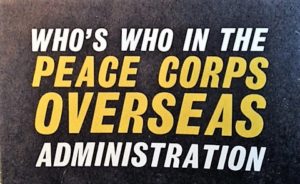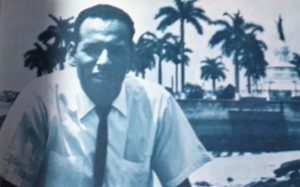Panama’s First Peace Corps Staff
 His 18th birthday arrived in 1944, in the middle of World War II, so David Boubion left Los Angeles, where he was born, by signing aboard the wartime Navy. He served aboard a destroyer in the campaigns at Iwo Jima and Okinawa. Discharged in 1946, he went home to resume the social work that he had become involved in before the war as an off-shoot of his work as a camp counsellor and camps director.
His 18th birthday arrived in 1944, in the middle of World War II, so David Boubion left Los Angeles, where he was born, by signing aboard the wartime Navy. He served aboard a destroyer in the campaigns at Iwo Jima and Okinawa. Discharged in 1946, he went home to resume the social work that he had become involved in before the war as an off-shoot of his work as a camp counsellor and camps director.
Enrolled in night classes at East Los Angeles Junior College, he organized a teenage group of Mexican-Americans in his neighborhood and got 60 to 80 members meeting once a week to participate in social and recreational activities.
“I thought to myself, ‘This is a lot of nonsense—doing this kind of work on my own and for nothing. I might as well make a living at it.”
He went to work for the Catholic Youth Organization from 1950 to 1954 and with Special Service for Groups from 1955 to 1956, in both cases working with teenage gangs. After he married Tola Cortez of Los Angeles in 1953, “well—I began to get a little more serious about studying.” And in the midst of his youth work, in 1955, he received his degree in sociology.
He then went on to two years of graduate work at the University of Southern California’s School of Social Work, where he was awarded an M.A. in that field in 1957.
“I worked full time even when I was going to school full time. I didn’t work in 1957 except as a psychiatric social worker in state mental hospitals, which was required for the master’s degree.” In the same year, he joined the Neighborhood Youth Association and was assigned to work with disturbed adolescents and problem families.
In 1959, City Councilman Edward Roybal asked Boubion to become his administrative assistant. He accepted and remained with Roybal for 3 ½ years, until Roybal was elected to Congress and Boubion came to the Peace Corps.
He joined the Peace Corps in February, 1963, took off for Panama two weeks later. His first Volunteers—18 health workers—followed him south on March 30. There ranks were subsequently expanded with 31 more health workers, seven agricultural extensionists and four rural community development Volunteers.
Research Document: Who’s Who in the Peace Corps Overseas Administration (1963)
The photographs are by Rowland Scherman, Paul Conklin and Jim Walls, first photographers for the agency.
No comments yet.
Add your comment